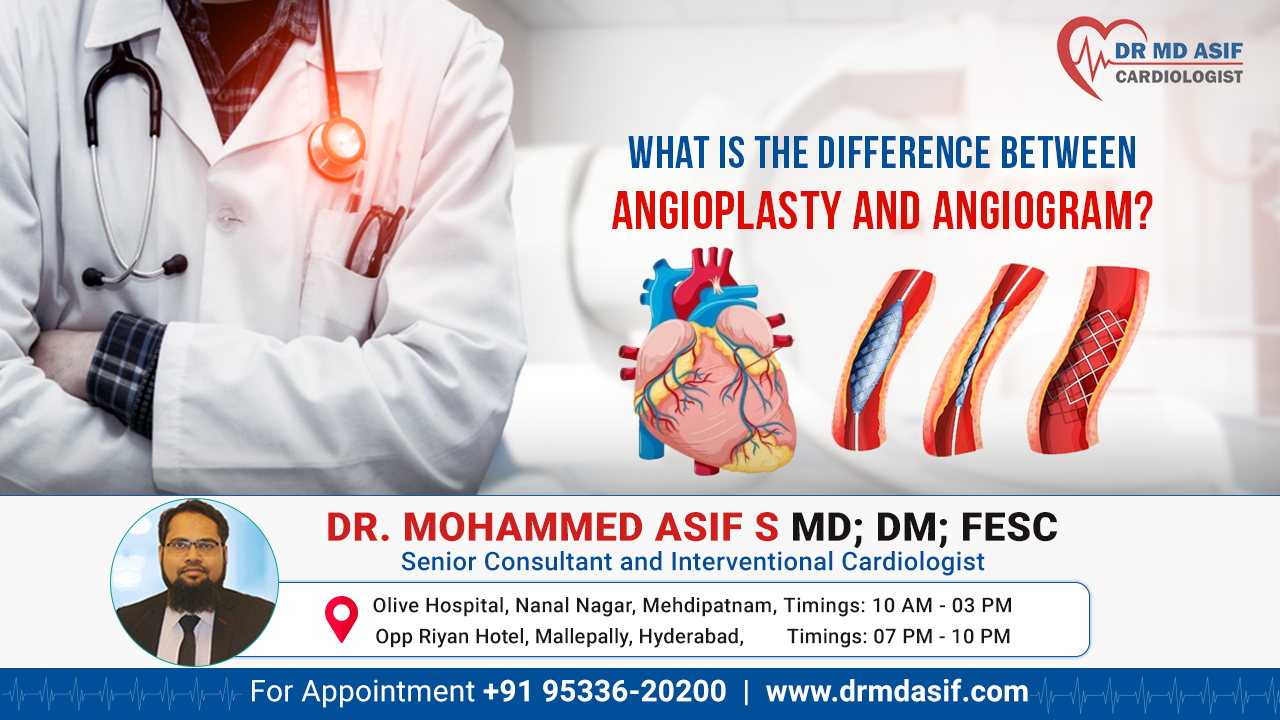Call us for any question
9533620200, 8179002888Meds Super Speciality Hospital
MallepallyTimings: 7 pm to 10 pm
mohammed4248asif@gmail.com

Blog s
What is the difference between angioplasty and angiogram?

Updated at: 06 Jan 2024
Our cardiovascular system is a network of arteries and veins. It plays a crucial role in maintaining our overall health. Medical intervention is necessary if any issues arise. The two common terms ever heard are angioplasty and angiogram. While both are related to the cardiovascular system, their medical procedure is completely different. Here, we will discuss the difference between angioplasty and angiogram with their unique roles for the cardiovascular system.
A deep understanding of Angioplasty and Angiogram:
An angiogram procedure is required to check the hearts potential condition. Through the process it examines the blood vessels. On the other hand, angioplasty is needed when the arteries become narrowed. This process helps widen those narrow arteries so that blood can flow easily.
Both of these methods are essential components of diagnostic testing and treatment for some illnesses, and they can be used independently.
What is angioplasty?
Angioplasty is a therapeutic procedure that often follows the diagnostic insights provided by an angiogram. It is designed to address blockages or narrowed arteries identified during the angiogram. This process aims to restore proper blood flow to the heart muscle.
During the angioplasty procedure, the cardiologist uses a balloon-tipped catheter, which is inserted into the site of the blockage artery. Once in position, the balloon is inflated, compressing the fatty deposits against the artery walls. It helps widen the blood vessels and restore blood flow. In some cases, the cardiologist stents a small mesh tube at the site to help keep the artery open.
Multiple angioplasty procedures are also available. These are:
Balloon pulmonary angioplasty
Cerebral angioplasty
PTA of the femoral artery
Coronary angioplasty
Carotid artery angioplasty
Renal artery angioplasty
Except above, the laser angioplasty option is also there. For this, the doctors use laser radiation to clear the blockages.
Also read: Potential of Angioplasty
What is Angiogram?
An angiogram is a diagnostic procedure that is designed to map the intricate network of blood vessels around the heart. It is also known as coronary angiography. Angiogram procedure helps cardiologists visualize any blockages or abnormalities in the arteries. The process involves injecting a contrast dye into the bloodstream, which makes the blood vessels visible on X-ray images.
Some of the best cardiologist in Hyderabad perform angioplasty procedures by inserting a thin and flexible tube, which is known as a catheter.
Multiple angiogram procedures are also available. These are:
Pulmonary angiogram
Aortic angiogram
Coronary angiogram
Cerebral angiogram
Renal angiogram
Peripheral angiogram
Except these above CT angiograms and MR angiograms are also there. But both these procedures may not require any contrast dye.
Also read: An in-depth look at Coronary Angiogram
Symptoms of angioplasty and angiogram:
The best cardiologist in Hyderabad suggests doing an angioplasty or angiogram procedure after checking certain symptoms. Both methods are useful for different kinds of medical conditions. Especially for those who have some blood flow issues.
The patient needs an angioplasty procedure with the below symptoms. These are:
Shortness of breathing
Regular chest pain
More than 50% of blockages in the main artery
More than 70% of blockages in the branch blood vessel
Any coronary or peripheral artery disease
The patient needs an angiogram procedure with the below symptoms. These are:
Breathing difficulty
Pain in the arm or jaw
Double vision with headache
Previously gone with stroke or attack
Procedure for angioplasty and angiogram:
Angioplasty procedure:
The first step is the same in both angioplasty and angiogram procedures. Angioplasty is a minimally invasive alternative to open-heart surgery. It provides an effective means of treating coronary artery disease. The doctor first gives anaesthesia to the patient. Then, the cardiac surgeon will make an incision to insert the catheter tube into the femoral artery. It helps to create a way to the blockage.
This catheter goes to the artery with a smaller balloon at the tip. After insertion, the surgeon inflates the balloon, which helps compress the blockage, and it is placed against the artery wall. After the process, the doctor needs to check the blood flow. For that, they will insert an iodine dye. The doctor can remove both the balloon and catheter after getting a satisfactory improvement.
Angiogram procedure:
The angiogram procedures first step is the same as angioplasty.
The doctor will give you anaesthesia to numb the incision area. Then, the doctor inserts a thin catheter through the arteries, usually from the groin or arm, to the coronary arteries near the heart.
The contrast dye is then injected through the catheter, allowing the X-ray machine to capture detailed images of the blood vessels. The clear images show blood oxygen levels, blood flow with pressure, and heart functionality. Also, it highlights those areas of narrowing or blockage that may be impeding blood flow.
Duration for angioplasty and angiogram:
Duration for angioplasty:
Many kinds of angioplasty procedures are there. As per the symptom, the doctor suggests which one is helpful for the patient. So, the time duration depends upon the type of angioplasty procedure. In some cases, it takes 30 minutes to 3 hours. In some procedures, the patient stays only one night at the hospital. After that, regular checkups are necessary for some days.
Duration for angiogram:
Normally, the angiogram procedure takes 10 minutes to 30 minutes. If there are more blockages or any abnormalities, then it will take more time. The information gathered from an angiogram serves as a crucial roadmap for healthcare professionals to determine the most appropriate course of action.
Conclusion:
For cardiovascular care, angioplasty and angiogram are distinct yet interconnected procedures. While angiograms provide a detailed map of the hearts blood vessels, angioplasty steps in as a therapeutic intervention, aiming to clear blockages and restore optimal blood flow. Understanding the differences between these two procedures will help you get some knowledge about your cardiac health. With all the medical procedures, it is advised to drink more water. It will help to flush out the dye from the body. Visit Dr. Asif to book an appointment for all heart-related concerns.
Comments

Be the first to Comment
Latest Post
-
⇨10 ways to control high blood pressure without medication
-
⇨Know the Dos and Donts after heart bypass surgery
-
⇨Angioplasty vs CABG : All You Need to Know
-
⇨A Closer Look at Angiography Risks and Benefits
-
⇨What is the difference between angioplasty and angiogram?
-
⇨Connections Between Depression and Heart Disease: What You Need to Know
-
⇨Finding the Best Cardiologist in Hyderabad: Tips and Tricks
-
⇨How to Recognize the Signs of a Heart Attack or Heartburn
-
⇨Why Are Permanent Pacemakers Necessary, and what to expect during surgery?
-
⇨The Impact of Patent Ductus Arteriosus on Quality of Life| Dr Asif
-
⇨What Are the Causes, Risk Factors, and Treatments of Ventricular septal defect?
-
⇨Exploring the Pacemaker Surgery Cost in Hyderabad: What You Need to Know.
-
⇨Discovering the Different Types of ASD: What You Need to Know
-
⇨The TAVR Surgery Cost in Hyderabad: A Comprehensive Guide| Dr. Asif
-
⇨Exploring the Advantages of TAVR: What You Should Know
-
⇨Visualizing Heart Health: An In-Depth Look at Coronary Angiogram
-
⇨Unlocking the Potential of Angioplasty: Types, Procedure Steps, and Promoting Speedy Recovery
-
⇨How Cardiac Resynchronization Therapy Device Work: A Complete Guide
-
⇨AICD Implantation in Hyderabad: A Comprehensive Guide for Heart Patients
-
⇨Pacemaker Surgery and Its Types: A Comprehensive Overview




Leave a reply